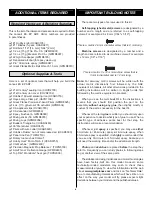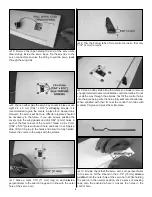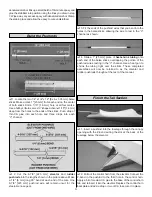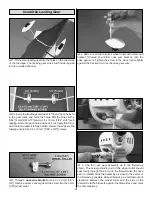
6
Before starting to build, take an inventory of this kit to make sure it is complete, and inspect the parts to make sure they
are of acceptable quality. If any parts are missing or are not of acceptable quality, or if you need assistance with assembly,
contact Product Support. When reporting defective or missing parts, use the part names exactly as they are written in
the Kit Contents list.
Great Planes Product Support
3002 N. Apollo Drive, Suite 1
Champaign, IL 61822
Telephone: (217) 398-8970, ext. 5
Fax: (217) 398-7721
E-mail: [email protected]
KIT INSPECTION
Hook & Loop Material
(3) Nose Wire Brackets
3 x 20 mm [1/8" x 1/8"] Machine Screw
3 mm [1/8"] Wheel Collar
2-56 x 1/8" [25 mm] Threaded Rod
3/32" [2.4 mm] Wheel Collars
(2) Anti-Rotation Pins
(14) 2.6 x 8 mm [7/64" x 5/16"] Self-
Tapping Screws
(4) 2.6 x 10 mm [7/64" x 3/8"] Self-
Tapping Screws
(5) Screw-Lock Pushrod Connectors
(2) 2.6 x 8mm [7/64" x 5/16"] Spinner
Screws
(3) 4-40 x 1/4" [6 mm] Socket Head Cap
Screws
(2) Landing Gear Straps
(4 pcs) Heat-Shrink Tubing
(4) Main Wheel Retainers
(2) Nose Wheel Retainers
(3) 8-7/8" [225 mm] Pushrod Wires
(2) 1/4" x 1/4" x 12" [6 x 6 x 305 mm]
Balsa Sticks
1800mAh 9.6V NiMH Battery pack
Electronic Speed Control (ESC)
(4) Control Horns w/Backplates
(2) 2-7/8" [73 mm] Aileron Pushrods
1/4" x 9-3/4" [6 x 247 mm] Carbon Wing
Joiner Tube
Radio Tray Brace
Radio Tray
Vertical Radio Tray Support
(2) Main Wheel Pant Straps
Nose Wheel Pant Strap
Kit Contents (not photographed)
KIT CONTENTS
1
4
3
9
10
13
14
14
11
10
2
7
Kit Contents
1.
Vertical Stabilizer & Rudder
2.
Horizontal Stabilizer & Elevators
3.
Fuselage
4.
Canopy
5.
Nose Gear
6.
Nose Wheel
7.
Main Landing Gear (L&R)
8.
Main Wheels (2)
9.
Wheels Pants (3)
10. Wing Panels w/Ailerons (L&R)
11. Cowl
12. Spinner
13. 9x6 Propeller
14. Wing Tips (L&R)
5
6
8
12







































